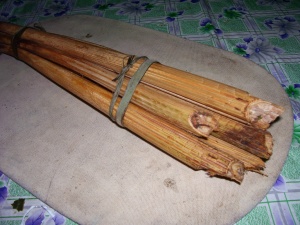Difference between revisions of "Wey"
Jump to navigation
Jump to search
| Line 5: | Line 5: | ||
[[Image:Richard Howard DSC00587-2007-palm.jpg|thumb|'''[[Da'un]] Wey'''<br>Photo by [[user:Richard Howard|Richard Howard]] ]] | [[Image:Richard Howard DSC00587-2007-palm.jpg|thumb|'''[[Da'un]] Wey'''<br>Photo by [[user:Richard Howard|Richard Howard]] ]] | ||
| − | [[Image:Tianyake rattan shoots.jpg|thumb|'''Ubud Wey'''<br>Photo by [http://www.flickr.com/photos/tianyake/sets/72157594491712169/ Tianyake] ]] | + | [[Image:Tianyake rattan shoots.jpg|thumb|'''[[Ubud]] Wey'''<br>Photo by [http://www.flickr.com/photos/tianyake/sets/72157594491712169/ Tianyake] ]] |
== Common Names == | == Common Names == | ||
Revision as of 11:45, 30 November 2007
Common Names
- Kelabit
- wey (wae)
- English
- rattan palm, cane
- Malay
- rotan
Encyclopedic info
- Scientific name
The following genus of rattan palms have been identified in Pa' Dalih (1)
- Daemonorops
- Calamus
- Korthalsia
- Plectocomia
- Ceratobulus
- English
- The cane fibre from the rattan palm is used for tying, and weaving baskets and mats (1)
- The fruits are generally edible (1)
- The shoots of most varities (eg. wey pa'it) are edible, and eaten as vegetables (1)
- Malay
References
- Ethnobotany of the Iban & Kelabit by Hanne Christensen
- Royal Botanic gardens, Kew
- Wikipedia



